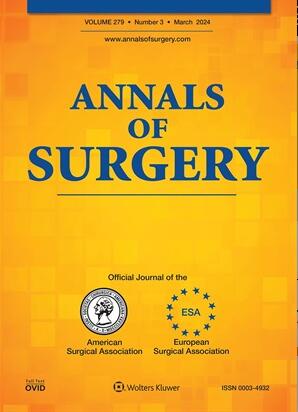淋巴显微手术对四肢淋巴水肿自然进展的改善。
IF 6.4
1区 医学
Q1 SURGERY
引用次数: 0
摘要
目的探讨完全消血治疗(CDT)和淋巴水肿显微手术(LM)对四肢淋巴水肿自然进展的影响。摘要背景数据肢体淋巴水肿的自然进展包括间质淋巴积聚、频繁的蜂窝织炎、脂肪沉积和纤维化,这些仍未被研究。方法前瞻性收集2011年11月至2019年9月期间接受CDT(61例)或LM(118例)治疗的四肢淋巴水肿患者的数据,随访2年。主要结果包括台湾淋巴显像分期(TLS)评估淋巴引流;蜂窝织炎的感染发作;脂肪形成的肢体周长和体积差异;组织柔软度和纤维化。次要结果是淋巴水肿特异性生活质量(lyqol)问卷。结果随访1年,LM组平均TLS(3.77±1.48比2.67±1.33,P<0.0001)和体积差(43.2±25.8%比31.7%±21.7%,P=0.00025)均有显著改善。此外,在2年的随访中,LM组蜂窝织炎发作次数(2.39±2.05比0.77±1.04,P<0.0001),周向差异(23.4±11.3%比14.3±11.0%,P<0.0001)和组织柔软度(2.41±1.15比1.42±0.633,P<0.0001)显著减少。在LM患者1年和2年时,所有5个淋巴结结构域均有改善(均P<0.0001)。CDT组的主要或次要预后无显著改善。结论与CDT组相比,LM组淋巴引流明显增加,蜂窝织炎和脂肪生成发生率降低,纤维化减少,生活质量提高。本文章由计算机程序翻译,如有差异,请以英文原文为准。
Improvement of the Natural Progression of Extremity Lymphedema Treated With Lymphatic Microsurgery.
OBJECTIVE
To assess the effect of complete decongestive therapy (CDT) and lymphedema microsurgery (LM) on the natural progression of extremity lymphedema.
SUMMARY BACKGROUND DATA
The natural progression of extremity lymphedema includes interstitial lymph accumulation, frequent cellulitis, adipose deposition, and fibrosis, which remain unexplored.
METHODS
Prospectively collected data of patients with extremity lymphedema managed with either CDT (61 patients) or LM (118 patients) with a follow-up of 2 years between November 2011 and September 2019 were analyzed. The primary outcomes included Taiwan lymphoscintigraphy staging (TLS) to assess lymphatic drainage; episodes of cellulitis for infection; limb circumferential and volumetric differences for adipogenesis; and tissue softness for fibrosis. The secondary outcome was a lymphedema-specific quality-of-life (LymQoL) questionnaire.
RESULTS
At 1-year follow-up, the LM group demonstrated significant improvements in mean TLS (3.77±1.48 vs. 2.67±1.33, P<0.0001), and volumetric difference (43.2±25.8% vs. 31.7%±21.7%, P=0.00025). Moreover, at 2-year follow-up, the LM group exhibited a significant reduction of episodes of cellulitis (2.39±2.05 vs. 0.77±1.04, P<0.0001), circumferential difference (23.4±11.3% vs. 14.3±11.0%, P<0.0001), and tissue-softness grade (2.41±1.15 vs. 1.42±0.633, P<0.0001). Improvements were observed across all five LymQoL domains at 1 and 2 years in patients with LM (all P<0.0001). No significant improvements in the primary or secondary outcomes were noted in the CDT group.
CONCLUSIONS
The LM group had significantly increased lymphatic drainage, decreased episodes of cellulitis and adipogenesis, reduced fibrosis, and improved quality of life compared to the CDT group.
求助全文
通过发布文献求助,成功后即可免费获取论文全文。
去求助
来源期刊

Annals of surgery
医学-外科
CiteScore
14.40
自引率
4.40%
发文量
687
审稿时长
4 months
期刊介绍:
The Annals of Surgery is a renowned surgery journal, recognized globally for its extensive scholarly references. It serves as a valuable resource for the international medical community by disseminating knowledge regarding important developments in surgical science and practice. Surgeons regularly turn to the Annals of Surgery to stay updated on innovative practices and techniques. The journal also offers special editorial features such as "Advances in Surgical Technique," offering timely coverage of ongoing clinical issues. Additionally, the journal publishes monthly review articles that address the latest concerns in surgical practice.
 求助内容:
求助内容: 应助结果提醒方式:
应助结果提醒方式:


